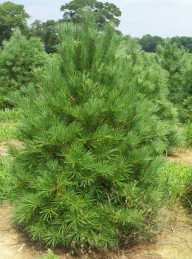 Did you know that Pinus strobus (Eastern White Pine) played a notable role in America’s history? In colonial days, the best trees were reserved by the King and the Royal Navy for masts on British ships. Lumber from Eastern White Pine is very light, yet strong. The versatile lumber was easy to cut, shape and finish. Great Britain decided they needed this versatile lumber to build the strongest and fastest ships. The King assumed ownership of the best Eastern White Pines within 10 miles of any navigable waterway. All specimen trees were branded with “The King’s Broad Arrow”.
Did you know that Pinus strobus (Eastern White Pine) played a notable role in America’s history? In colonial days, the best trees were reserved by the King and the Royal Navy for masts on British ships. Lumber from Eastern White Pine is very light, yet strong. The versatile lumber was easy to cut, shape and finish. Great Britain decided they needed this versatile lumber to build the strongest and fastest ships. The King assumed ownership of the best Eastern White Pines within 10 miles of any navigable waterway. All specimen trees were branded with “The King’s Broad Arrow”.
Houses were built and tools were made with the majestic Eastern White Pine. The inner bark was dried and ground into flour. Tea was made from the needles. The bark was applied to wounds and distilled into cough remedies. The white pine was the colonist livelihood. Here these grand trees sat on their property and they couldn’t touch them because the King said so. They paid no attention to the “Broad Arrow” protected trees and harvested them anyway putting the wood to use. Rebellion from local settlers clashed with British authorities in such scuffles as “The White Pine War’ and “The Pine Tree Riot”. These were the first acts of rebellion against British rule. The Eastern White Pine was the emblem on the first colonial flag. The Revolutionary War was about many things and the Eastern White Pine weighed heavy on the colonist desire for independence.
Soft, flexible blue-green needles and pyramidal form make Pinus strobus an exceptional ornamental. Favored for its beauty and fast growth rate, Pinus strobus is a valuable tree. It is hardy for zones 3 through 8 and responds well to shearing. This low maintenance plant is widely used as a screen, in park and estate plantings and wind breaks.
Plant some history!
